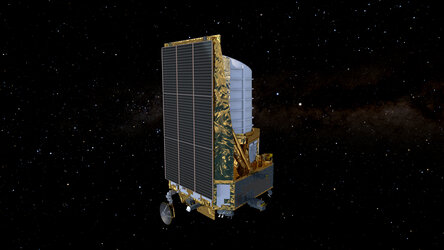
Euclid spacecraft from all sides – starry background
Artist impression of the Euclid mission in space. The spacecraft is white and gold and consists of three main elements: a flat sunshield, a large cylinder where the light from space will enter, and a 'boxy' bottom containing the instruments. The sunshield always faces the direction of the Sun and protects the telescope from the light of the Sun. Euclid’s backside holds the solar arrays that power the satellite.
The three small golden cylinders pointing into different directions are the star trackers. The high-gain antenna is the dish sticking out from underneath the satellite. The bottom of the satellite also holds several thrusters, used to keep the satellite on its correct orbit.
ESA's Euclid mission is designed to explore the composition and evolution of the dark Universe. The space telescope will create a great map of the large-scale structure of the Universe across space and time by observing billions of galaxies out to 10 billion light-years, across more than a third of the sky. Euclid will explore how the Universe has expanded and how structure has formed over cosmic history, revealing more about the role of gravity and the nature of dark energy and dark matter.
Acknowledgement: Work performed by ATG under contract for ESA.






